Cytoplasmic inheritance also termed as maternal inheritance or maternal effect. A cytoplasm comprises some autonomous organelles like mitochondria and plastids that possess their own genetic material. Mitochondria is present in both animal and plant cell, whereas plastids are only found in the plant cell. As we know, nucleic acids like DNA and RNA are responsible for the inheritance of the genes.
DNA inherits genes from one generation to the next generation among different individuals. Therefore, the genes play an important role in forwarding the parents’ genetic features to the offsprings. On further study of inheritance, the idea of cytoplasmic inheritance has been originated.
In cytoplasmic inheritance, the cytoplasmic genes and the cytoplasmic particles participate in the process of inheritance. The study of cytoplasmic inheritance has been studied in many plants and animals. Several studies have revealed that the extranuclear material, i.e. cytoplasmic elements, can carry out the biological process called inheritance.
The gamete which contributes the cytoplasm is the female gamete that carries both nuclear and cytoplasmic material, whereas male gametes do not carry cytoplasmic material. This is why cytoplasmic inheritance also called maternal effect, as the phenotype of the offspring, is decided only by the mother or a female (holds the cytoplasmic material).
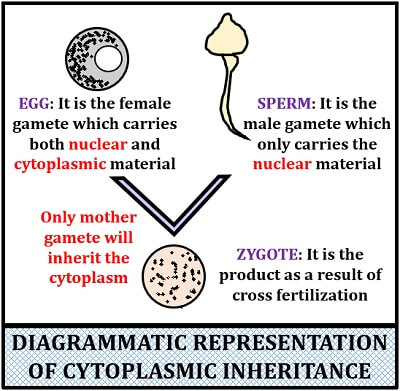
After the cross-fertilization, a zygote forms and whatever cytoplasm is coming to the zygote is only due to the female gamete. You will get to know the definition, characteristics and a few examples of the cytoplasmic inheritance In this context.
Content: Cytoplasmic Inheritance
Definition of Cytoplasmic Inheritance
Cytoplasmic inheritance can define as one of the types of inheritance where the genetic characters are passed on to the next generation utilizing cytoplasmic elements in the organisms like animals and plants. The cytoplasm consists of autonomous organelles like mitochondria and plastids that possess DNA.
Salient Features of Cytoplasmic Inheritance
The cytoplasmic inheritance includes the following features:
- The cytoplasm inherits information among different organisms through Plasmagenes.
- The plasmagenes resides within the cytoplasm or remains outside the nucleus.
- Plasmagenes also have the capability of self-replicating, like the chromosomal genes (DNA or RNA).
- The offspring receive the cytoplasm only from the female gamete, not from the male. Therefore, only the female gamete is responsible for transferring plasmagenes to the offspring. Hence, cytoplasmic inheritance is known as maternal inheritance.
- Plasmagenes are also capable of mutation.
- Cytoplasmic inheritance can be studied by reciprocal crossing over.
- The results of the reciprocal crossing are not the same.
Examples of Cytoplasmic Inheritance
A few examples will help us understand the theory of cytoplasmic inheritance more in detail. Several experiments like kappa particles, carbon dioxide sensitivity, shell coiling etc. showed the existence of the maternal or cytoplasmic inheritance.
Kappa Particles Inheritance in Paramecium
It was studied in the strain of Paramecium aurelia by the scientist Sonneborn in the year 1938. Paramecium aurelia produced two types of strains, namely killer strain and sensitive strain. The killer strain should have a dominant gene plus kappa particles. The sensitive strain contains one of the two elements, i.e. either dominant gene or kappa particles. The dominant genes carrying kappa particles will produce a toxin paramycin.
To understand the concept of kappa particle inheritance, let us cross a pure killer and sensitive strain. The pure killer strain will possess both dominant genes, i.e. KK plus a protein factor Paramycin. The pure sensitive strain will only have the recessive gene. During crossing over, there will be conjugation between KK gene with kk gene. If the duration of conjugation is less than 3 minutes, only the nuclear exchange will occur.
Therefore, one dominant and one recessive gene will exchange between the killer and sensitive strains during crossing over. After crossing over, two offspring will produce known as ex-conjugants. One killer strain (Kk) and one sensitive strain (Kk) will be produced due to crossing over. The ex-conjugant Kk will behave like a killer strain because of the dominant gene ‘K’ and kappa particles.
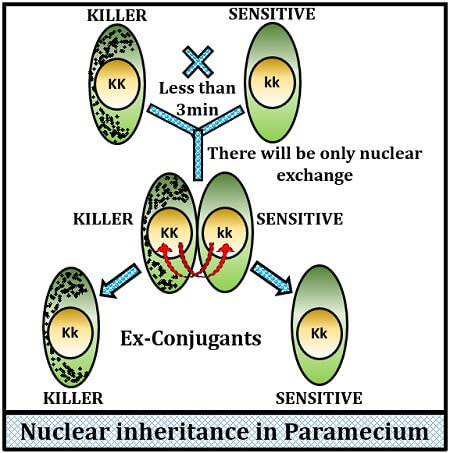
Now, let us understand the concept of nucleoplasmic inheritance by the same crossing over. If the conjugation duration (between KK and kk gene) lasts more than 3 minutes, then the nuclear exchange will occur along with cytoplasmic exchange. During crossing over, one dominant and one recessive gene will be exchanged along with the cytoplasmic exchange and called nucleoplasmic inheritance. After crossing over, two offsprings will be produced called ex-conjugants. Both killer strain will produce as a result of this crossing over.
Carbon Dioxide Sensitivity in Drosophila
Carbon dioxide acts as a paralyzing or anaesthetic agent, which can paralyze several strains of the Drosophila. In 1958, Heritier and Teissier studied the carbon dioxide sensitivity in Drosophila melanogaster, where he found high sensitivity towards carbon dioxide. L. Heritier and Teissier experimented the carbon dioxide sensitivity in the breeding strain of D. melanogaster, in which they crossed the sensitive strain with the normal strain.
After the experiment, L. Heritier and Teissier concluded that the sensitive mother would produce sensitive offsprings according to the cytoplasmic inheritance. Sometimes, the sensitive male produces sensitive offsprings after crossing over with the normal female Drosophila. The sensitivity produced by the male Drosophila only lasts for the first generation.
L. Heritier and Teissier then further studied the sensitivity factor where they found the virus-like particles in the cells of sensitive flies and named it as sigma particle. L. Heritier and Teissier concluded that the sensitivity in Drosophila is due to the presence of sigma factor. Sigma particle is present in different strains of Drosophila. Sigma has a particle size of 0.07-micron diameter, and it is heritable due to the presence of DNA.
Examples of sensitive drosophila strains: D. melanogaster, D. Algonquin, D. pseudoobscura, D. robusta, D. affinis etc.
Shell Coiling in Limnaea
In 1920, Arthur Boycott was the first to study the maternal effect of shell coiling in the snail. Arthur Boycott studied the maternal effect in Limnaea peregra. There are two types of coiling found in the Limnaea peregra:
- Dextral coiling: This type of coiling is towards right-handed.
- Sinistral coiling: This type of coiling is towards left-handed.
For the dextral coiling, a dominant gene ‘D’ is responsible. If there is either “DD” or “Dd” is present in a snail, there will be dextral coiling. For the sinistral coiling, a recessive gene ‘d’ is responsible. If there is “dd” gene present in a snail, there will be sinistral coiling. The shell coiling in snail is only decided by the genotype of the mother. Let us understand the concept of the maternal effect of shell coiling in Linnaea by taking a couple of crossing over.
Crossing over between DD female and dd male
By this crossing over pure dextral female and a sinistral male, a zygote (Dd) will produce dextral coiling in the F1 generation. Then, the intercrossing of Dd gene will result in the formation of DD, Dd, Dd and dd genes in the F2 generation where each has dextral coiling. According to the study by Alfred Sturtevant, the dd offspring will have dextral coiling due to maternal effect or the dominant ‘D’ gene. Then, three dextral and one sinistral offspring will be produced with a phenotype of 3:1 in the F3 generation.
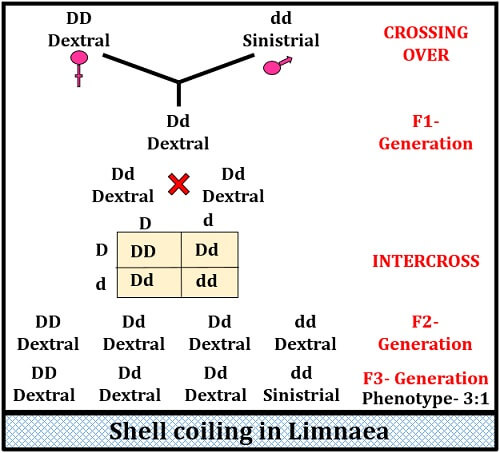
Crossing over between dd female and DD male
By this crossing over of pure sinistral female (dd) and a dextral male (DD), a zygote (Dd) will be produced with dextral coiling in the F1 generation. Then, the intercrossing of the Dd gene will result in DD, Dd, Dd and dd in the F2 generation where each has dextral coiling. The dd offspring will again have dextral coiling due to the maternal effect of the dominant gene ‘D’. Then, three dextral and one sinistral offspring will be produced with a phenotype of 3:1 (in the F3 generation).
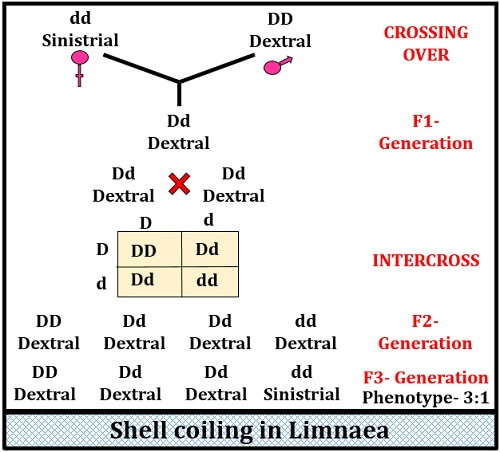
Plastid Inheritance in Mirabilis jalpa
Mirabilis jalpa also called 4- O’Clock plant, which acts as a model organism to study the cytoplasmic inheritance. In 1900, the scientist Carl Correns first studied the plastid inheritance in Mirabilis jalpa. In his experiment, he found three different strains of Mirabilis jalpa. The strains are of green colour, pale green colour and variegated colour.
A female branch of green colour will produce green leaves only (no matter what is the colour of the male branch). Similarly, a female branch of pale-green coloured will produce pale green leaves. The variegated female branch will produce different coloured leaves. The green colour is due to the presence of chloroplast.
The pale green colour is due to the presence of leucoplast. The variegated colour is due to all three pigments, namely chloroplast, leucoplast and chromoplast. Let us understand this concept by looking at the picture given below. A first circle (yellow-coloured) indicates a female individual (G, P and V).
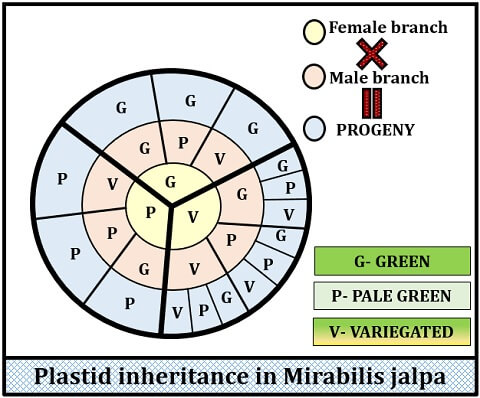
A second circle (cream-coloured) represents the male individual of all three types. Finally, a third circle (blue-coloured) represents different progenies (an outcome of female and male branch crossing). If the female branch is green, all the progenies will be green in colour. A pale-green coloured female branch will produce pale green coloured progenies, and a variegated female branch will form variegated progenies.
